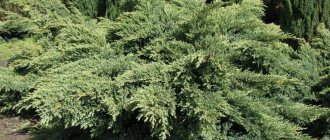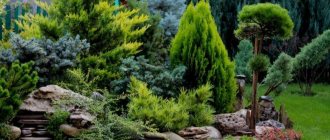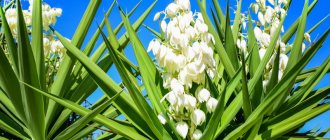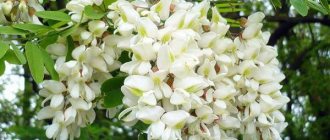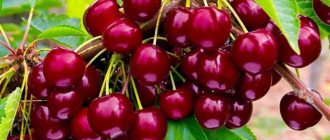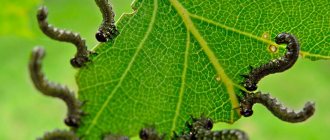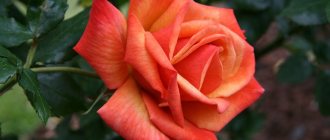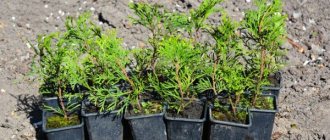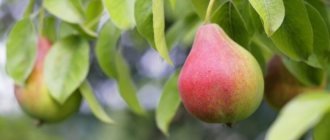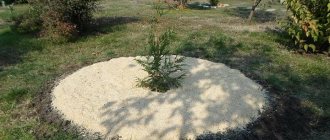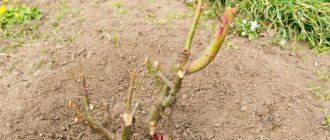Evergreens are not the only group of plants that do not lose their decorative properties even in winter. You'd be surprised how many crops stay green until spring!
From the point of view of the average person, evergreen and wintergreen crops are one and the same, because both retain the rich color of their foliage in winter. And yet these plants have certain differences.
Evergreens are plants whose leaves live for 2-3 seasons, and wintergreens are those crops whose foliage does not fall in the fall, but remains until spring. Nature has increased the duration of photosynthesis, giving wintergreens the ability to retain last year's foliage until this year's leaves appear on the plant. Let's take a closer look at some of them!
Badan
The skyward peduncles of bergenia decorate the flowerbed, and its large leathery leaves refresh the flower garden in early spring. In addition, this plant is very hardy and does well in shaded areas with loamy soil.
In the spring, after the snow has melted and the soil has dried out a little, the most damaged leaves are removed from the bergenias. Please note that all shoots and leaf blades cannot be removed, no matter how untidy they may seem to you, because... Nature endowed bergenia with non-freezing leaves for a reason. They are necessary for the plant to maintain the required temperature of the shallow rhizomes of the plant.
At the end of April - beginning of May, the plant begins to bloom and continues to do so until the end of June. In autumn, depending on the variety of bergenia, its leaves may acquire a bronzed or bluish-brown tint, which remains until spring.
Holly Meserve
Green shiny leaves with deep red petioles and shiny dark red fruits are typical for different varieties of this shrub.
Holly leaves and fruits are poisonous!
Flowers/fruits
The flowers are white, inconspicuous; red berry-like drupes.
Care
Suitable for curly haircuts.
Note
Plant for mild climates. In central Russia, compact varieties can be grown in containers.
Related article:
The art of change, or How to change the area of your plot
Holly Meserve
Euonymus Fortune
A relatively low, 50-60 cm plant, which can grow in “volume” up to 2-3 m, so it can be grown on a trellis. Among Fortune's euonymus varieties there are both monochromes and bicolors, which makes this culture especially popular among landscape designers.
Euonymus grows slowly, so it does not require frequent pruning. In early spring, all damaged and frozen leaves are removed from the euonymus. Most varieties of this type of shrub can boast of their frost resistance, but in the first years it is recommended to cover it during the winter. Adult plants are not covered, but their trunk circles are mulched with sawdust or peat.
- Euonymus Fortune
The most elegant and very frost-resistant euonymus, which decorates the garden all year round thanks to its variegated leaves.
Monetary loosestrife
A moisture-loving ground cover that fits perfectly into the composition with any body of water. Although loosestrife prefers moist soils, it really does not like stagnant water, so when you decide to plant it on your site, you will need to provide it with good drainage. For wintering, the loosestrife is not covered, but sanitary pruning is carried out, and the soil around the bush is loosened and mulched with humus or compost.
Powerful creeping stems tightly cover the ground, not giving weeds the slightest chance. This plant is very unpretentious, but maximum decorativeness can be achieved only by planting it in a sunny area and providing it with sufficient watering, since the loosestrife loves moisture very much.
- Unquestioned groundcovers - the best plants for garden paths
6 Ground Cover Plants You Can Walk On.
Mini accents that you can’t remain indifferent to all year round
Evergreens do not always have to be large to play their role in compositions. And in the design of such places as rock gardens, narrow ridges, ribbon flower beds, small front gardens, you do not use ordinary thuja or fir. Even the most modest garden ensembles will have their stars - dwarf varieties and types of familiar evergreen crops that seem especially spectacular. Shrubs and mini-sized trees attract attention with their perfect forms, crown density, and eye-catching colors. They are the most luxurious accents available.
Blue spruce "Conica" (Picea glauca). © FD Richards
Cherry laurel (Prunus laurocerasus). © English Hedging
Oriental flatweed "Aurea Nana" (Platycladus orientalis) or eastern thuja (Thuja orientalis). © FD Richards
Cypress blunt-leaved “Nana Gracilis” (Chamaecyparis obtusa). © georgeweigel
Mountain pine, or European dwarf pine (Pinus mugo). © Jim Harding
Black pine "Nana" (Pinus nigra). © hgeers
There are also mini-stars among the flowering winter-green shrubs. Various varieties of Creeping Rhododendron (Rhododendron repens), today classified as forms of Rhododendron forrestii, are practically invisible under the wonderful inflorescences. Cherry laurel also has its own dwarf variety - the compact, 30-centimeter Mount Vernon, whose bush diameter is 2.5 times its height.
But still, the main stars among miniature evergreens are conifers. The best decorative mini-varieties can safely include dwarf spruce, pine, etc.:
- A curvy beauty that will forever make you forget about boring ordinary spruce trees, the compact favorite is the Blue Spruce variety “Conica” (Picea glauca). Even in old age, this beauty will not exceed 3 meters in height; with its dense conical crown, it will fit perfectly even into a flowerbed of minimal size.
- blunt-leaved cypress , not exceeding 2-2.5 m .
- The most famous of the dwarf pines is the “Pug” variety of Mountain Pine or European dwarf pine (Pinus mugo), which grows so slowly that it reaches its maximum meter height only after decades.
- The main candidate for decorating flower beds is Black Pine (Pinus nigra) of the “Nana” variety, limited to 3 meters and with an amazingly compact crown.
- The dwarf favorite among thujas is the variety “Aurea Nana” of the eastern thuja (Thuja orientalis, according to recent research it is more correct to call Biota or Oriental thuja (Platycladus orientalis), which is limited to a meter in height. The needles, similar to dense fur, with a bright yellow color glow in sunny areas, conquer both texture and unusual density.
Heather
Heathers are universal plants that will be equally appropriate in a variety of compositions. Tall (40-60 cm) varieties are a good background for multi-level compositions. Medium-sized (30-40 cm) are often used to create compositions in rockeries and rock gardens. Dwarf heathers, plants up to 30 cm high, are planted in groups that form real thickets. The main thing you need to know about heather is that it loves the sun very much.
In the southern regions and central zone, heather overwinters without additional protection from the cold. But if your area is characterized by cold and snowless winters, then it would be better to play it safe: mulch and cover with spruce branches.
- Everything you wanted to know about heather - planting, care, propagation, popular varieties
Detailed instructions for growing and propagating heather for those who decide to transform their garden with the help of this stylish and spectacular plant.
Heuchera
Heucheras are very unpretentious, but prefer light and well-drained slightly acidic soils. These decorative foliage plants can decorate any garden. The saturation of the color of the leaves, and in heucheras it can be not only green, but also silver and even burgundy, largely depends on the planting location. Most plants prefer partial shade or planting on the western or eastern side of the site.
Over time, the bush begins to disintegrate and “expose” the middle, so every 3-5 years in the spring the heuchera is divided into several parts and planted. Despite the fact that at some point the leaves of the heuchera may begin to lose their decorative effect, they should not be removed under any circumstances, since they help the plant retain heat. You can get rid of dried leaf blades only in the spring, when the heuchera produces new foliage.
- Heuchera in the garden - planting, growing and care
Do you want to grow heuchera with beautiful decorative leaves in your garden? This article will help you!
ENVIRONMENTAL BLOG
Evergreens maintain their green color throughout the year, regardless of the season. This is a rather specific type of plant, which has a number of undeniable advantages over deciduous plants. Evergreen trees and shrubs can delight with their rich color all year round, which is very important for landscaping around the house, in parks and public gardens. We will talk about the features of evergreen plants in this article.
Where do evergreens grow?
On our beautiful planet, needle-shaped evergreen forests grow - these are mainly forests of the Northern Hemisphere. Evergreen trees such as spruce, pine, fir, podocarp and others are widespread here . In addition to needle-shaped evergreens, there are also deciduous evergreen trees, vines and shrubs that inhabit the temperate rain forests of the Southern Hemisphere. The xerophilic (thick, hardened foliage that resists water loss) coastal forests of the Northern Hemisphere are home to evergreen rhododendrons (Pontic, dense rhododendron), cherry laurel and holly.
Most tropical rain forests contain broadleaf evergreens. Their foliage is usually thicker and more leathery than that of common deciduous trees. Additionally, each leaf can remain on an evergreen tree for two or more years. An example of this is the evergreen cocoa tree. Cold-temperate and arctic regions typically grow cone-shaped shrubs or coniferous trees such as pine and spruce.
Evergreens in gardening art
The unusual forest color of spruces and pines serves as an effective basis for any park or garden, and decorative bushes are a kind of addition. Such a union of tiers will ensure the attractiveness of the site throughout the entire life of evergreens.
There are various options for combining needle-shaped and deciduous evergreens for planting near the house. For example, spruce, honeysuckle, cypress, juniper, fir, ivy, boxwood, bristlecone pine, yew, thuja and some types of rhododendron can perfectly zone the landscape, especially in combination with decorative seasonal plants.
When planning planting on your site, it would be right to focus on evergreens. It is they who must form the basis on which all other inhabitants of the garden will rely. After the completion of seasonal flowering, such a garden will not be boring even in the winter season. If your garden seems empty and bare, this is a sure sign that you should add winter green plants to your garden.
Evergreen trees and bushes can be placed separately from each other or in groups, combining their different types. Evergreens are suitable for hedges, which is not only practical, but also environmentally friendly.
With the help of evergreens it is possible to satisfy any aesthetic needs in design. Miniature shrubs, which can be given almost any shape, fit perfectly into small gardens. If the area of the territory allows, then you should definitely plant majestic tall trees. Moreover, in both cases, the height and size can be adjusted by trimming. Evergreens are a good material for gardening creativity. Shrub sculptures, or topiary as they are also called, can increasingly be seen not only in city parks, but also near residential buildings.
The undeniable advantage of flowering varieties of evergreens is that they do not require much additional care and will not complicate the gardening schedule, as happens when other crops bloom. Thus, with minimal effort, you can ensure a well-groomed look in almost any garden.
The most popular evergreens
Below are examples of the most famous evergreens:
- Spruce trees will be a good solution for garden decoration. Of course, not every variety of this majestic tree will suit every garden. European or common spruce is the most common evergreen tree when decorating summer cottages, squares, and alleys. Many varieties of this tree have been developed, differing in needle shade, size and growth rate. On average, the height of spruce is from 30 to 50 meters, and the width is up to 5 meters. This cone-shaped tree can live up to 300 years without any care. Of course, more decorative varieties of spruce are suitable for domestic cultivation: “Akrokona”, “Inversa”, “Maxveli”, “Tompa”. In addition, in addition to its aesthetic value, common spruce will become a good barrier from winds and snow for other plants, and will also serve as raw material for useful medicinal tinctures.
- A slightly less common coniferous plant is Araucaria chilean . The cone-shaped crown of this tree with triangular needles looks very original. The younger the tree, the more picky it is to growing conditions and needs additional care, and the older it gets, the more severe conditions it can withstand.
- Thuja . A dense crown of unusual needle-like leaves and a pleasant aroma make the evergreen thuja shrub a leader in landscape design. To date, more than 100 species of thuja have been bred, among which tall and miniature shrubs with a variety of colors - green, golden, blue and reddish shades enrich the garden with their wide range. These evergreens are excellent for pruning and haircuts, but to keep their shape, it is better to tie the thujas with thick rope for the winter.
- Japanese umbrella fir is a pyramidal coniferous tree that is quite picky about environmental conditions. For good fir growth, only moist, oxidized soil is suitable. Needles up to 15 centimeters long resemble umbrellas, which explains its second name “umbrella pine.”
- Recently, small evergreen boxwood , which are used to decorate borders and fences, are gaining popularity in personal plots. The ability to grow in shaded areas and be trimmed in a variety of shapes and levels of difficulty make this plant suitable anywhere in the garden. It is worth remembering that boxwood leaves are poisonous and unsuitable for consumption. Therefore, after working with a plant, you must wash your hands!
- Rhododendron is one of the most famous flowering shrubs, but it is not the only one.
- Several Mahonia bloom yellow flowers in spring.
- Photinia Fraser will decorate the garden with small white fruits during the flowering season .
- Wintergreen acuminate - a spectacular fruit plant with red berries is ideal for combining with other types of plants, as it easily gets along with its “competitors”.
"Compact" evergreens
It is not at all necessary to focus on large winter-green trees and bushes. Today it is impossible to imagine small front gardens, alpine hills and narrow flower beds without dwarf varieties of evergreen plants. Just like in large areas, they are used to create mini-accents in areas of limited area. Thanks to its small size, it will be easy for anyone, even a completely inexperienced gardener, to maintain the neat shape of plants in perfect condition.
The compact leader of landscape zones is blue spruce , the height of which does not exceed 3 meters, even in old age. With its thick cone-shaped shape, it will fit into any flower bed. In second place in popularity is the slow-growing cypress . Japanese black pine , despite its impressive name, is completely harmless in appearance due to its compact crown and small 2.5-3 meter height. The oriental thuja by a meter height and a bright yellow color.
There are many flowering miniature evergreen shrubs that will enhance the area with their discreet and “intelligent” appearance. Among them is cherry laurel , whose crown diameter is more than twice its height. During the flowering season, the inflorescences of creeping rhododendron and Forrest rhododendron completely envelop the entire bush.
Juniper “Blue Carpet” is a very good option for decorating cascades over walls. This fast-growing plant with silver-blue evergreen foliage reaches 15 cm in height and 15-50 cm in width. Japanese garden juniper is a dwarf evergreen plant that reaches a height of 60 cm and forms a dense mat 30 to 40 cm wide.
This concludes our brief review of evergreens. And although we have not mentioned all the representatives of the flora that fall into this category of plants, most evergreen trees, bushes and vines have the same ability to delight our eyes and souls with their bright greenery even in the middle of winter.
Source: Environmental blog (ruslo.info)
- 7
Shares
Geranium macrorhizomatous
The carved palms of the leaves of large-rhizome geranium look impressive even in the spring-summer period, when nature already has something to present to a sophisticated viewer. What can we say about early spring, when the palette of colors is much poorer, and even a small green spot among the snow that is beginning to melt can dramatically transform the landscape.
In the middle zone, geranium usually overwinters without additional shelter. However, if the regions often have winters without snow, then in this case additional protection from the cold will not hurt.
- What is the difference between geranium and pelargonium or are they different names for the same plant?
To properly care for a plant, you need to know what it is called. Let's figure it out together!
Lianas and mosses
They can be combined into a single group because they are less popular than trees and shrubs. However, when used correctly, they can look no less impressive and at the same time much more original.
Ivy is a climbing evergreen deciduous plant. Loves warmth, loose acidic soil, and an abundance of garters that can be braided. Its leaves reach a quarter of a meter in length, their color is greenish, yellowish or grayish. In autumn, flowers appear on the branches - small, green and umbrella-shaped - which by spring become large black berries with a pleasant nutmeg scent. They can be used as a spice.
Bindweed is an evergreen plant that does not lose its attractiveness in winter. The leaves are silver-gray and blooms all summer, producing pink buds that open into white flowers. Needs supports, can easily braid a fence, hedge, trellis, gazebo posts. During severe frosts, it is better to cover it from the cold.
Moss - garden varieties of moss look very impressive and can replace a lawn, as they can easily overwinter under a layer of snow. They grow well in the shade, where the soil is acidic and humid. They do not require any special care and can actually grow on their own.
Evergreens are easier to care for than most others. Periodic watering, a little care before the winter period, interested observation of how things grow and spread - and even in winter the garden will look absolutely magical in summer.
Saxifrage
The genus Saxifraga has more than one hundred species. According to various estimates, it includes from 370 to 440 species. This plant has an incredible ability to survive even in the harshest conditions. Saxifraga looks best in the company of dwarf conifers. Saxifragas love the sun, but do not tolerate direct rays. Therefore, a taller plant is often planted on the southern side of the saxifrage, which acts as a kind of shield.
After the flowering period ends, and for saxifrage it lasts about a month and a half, the flower stalks must be removed, thus stimulating the formation of new shoots. Saxifragas usually do not require winter shelter, since most of them are able to tolerate temperatures down to -25°C.
- Saxifraga: secrets of care and reproduction
Saxifraga is an excellent plant for alpine slides or rockeries. Is it growing for you?
Serbian spruce
The crown of this elegant tree is the narrowest of all spruces; the tips of the drooping branches point upward. It is drought-resistant and tolerates severe air pollution, making it suitable for growing in cities.
Related article:
The art of change, or 4 more tricks for owners of small plots
Flowers/cones
Female cones are reddish; mature buds are brown.
Care
Removing dead branches.
Note
There are low copra (for example, the variety "Nana" reaches a height of about 4 m only after many years).
Serbian spruce
Dummer cotoneaster
A low (up to 30 cm) shrub that can grow up to 50 cm wide in a year. The reddish-brown shoots of Dummer's cotoneaster are covered with elliptical or oblong grayish-green leaves. In May and June, small white flowers bloom on the plant, and in September-October, spherical bright red berries appear on the bushes. But even then, when the berries fall off or dry on the branches of the bush, the cotoneaster will not lose its decorative value, since its drop-shaped waxy leaves will remain on the shoots even in winter, replaced by new ones only at the beginning of the next season.
Types of evergreens
The range of evergreens is very diverse. There are not only well-known conifers here, but also deciduous shrubs with powerful and beautiful flowering. Evergreen plants, varied in height, size, and growth rate, are suitable not only for large areas. Low-growing and miniature varieties do not take up much space and are very popular among owners of small plots.
Conifers
Once upon a time, coniferous trees were used exclusively for planting on city streets, but now they are often found in garden plots. Many gardeners have become true fans of these plants. The most common varieties of evergreen conifers:
- Spruce. An evergreen tree with stiff needles, resistant to severe frosts, and tolerates shade. Can grow in any soil and easily tolerates waterlogging. In garden design, medium-sized varieties are most often used, which are planted in mixborders and hedges. Dwarf spruce trees are placed in alpine hills and used in indoor floriculture.
- Cypress. A spectacular tree with original needles, giving the yew a special decorative effect. There are species with a pyramidal and curved crown. The monumental form of cypress has found application in the design of alleys on the territory of sanatoriums and recreation centers. Dwarf cypress varieties are common in indoor floriculture.
- Fir. The tree has a dense, cone-shaped crown, long, curved, bright green needles and beautiful purple cones. The tree is moisture-loving and requires abundant watering during dry periods. In addition to the usual varieties, fir has miniature forms that take root well in a small area and can withstand shading. Fir is planted in hedges, group compositions, paths and alleys.
- Boxwood. A small tree (10−12 m) with small dense leaves. In the axils of the leaves there are small white flowers collected in the form of a spikelet. The shiny foliage of boxwood is very decorative. The tree is planted in parks to frame roads; boxwood is trimmed into various bizarre shapes. The tree grows slowly and retains its shape for a long time.
- Yew. An unpretentious tree with dark green needles and bright red berries. The most shade-tolerant tree among conifers. Yew does not have a specific pine smell. Planted as a background in rock gardens and used in topiary compositions. The poisonous plant is used in classical homeopathy.
- Thuja. A plant with a rich color palette of needles (blue, yellow, green). This allows you to choose it for any landscape composition. Thuja is light-loving; not all species are frost-resistant. It tolerates pruning well and is often planted along alleys and in hedges.
In group plantings involving conifers, it is necessary to take into account that their roots grow strongly and in the future these trees may occupy a fairly large area.
Cypress
The most “neat” tree – its crown is dense and symmetrical. Even fully ripe fruit cones do not become shaggy; they decorate the branches with medium-sized light brown balls. Cypress usually emphasizes the high status of the dacha owner.
The capricious southerner, of the evergreen, pyramidal or Arizona species, overwinters well in the conditions of the Middle Zone if the temperature drop does not exceed -20 °C. Low-growing and dwarf varieties are considered the most suitable - they are easier to cover for the winter.
The best place for planting is semi-shaded, with fertile, loose soil that does not retain moisture. All cypress trees are demanding when it comes to watering, air humidity, and adding nutrients to the soil.
Juniper
A coniferous evergreen plant belonging to the Cypress family. It could be either a tree or a shrub. Common juniper (Juniperus communis) grows mainly in the Northern Hemisphere of our planet. However, in Africa you can also find your own juniper - the East African one. In the Mediterranean and Central Asia, this plant forms juniper forests. Quite common are low-growing species that spread along the ground and rocky slopes.
Today, more than fifty species of juniper are known.
As a rule, this is a light-loving and drought-resistant crop. Completely undemanding to soils and temperatures. However, like any plant, it has its own preferences - for example, it develops better in light and nutritious soil.
Juniper , like all coniferous plants, is a long-lived plant. Its average lifespan is about 500 years.
The needles of juniper are bluish-green, triangular, pointed at the ends. The cones are spherical in shape and gray or blue in color. Tap root.
Magical properties were also attributed to this coniferous plant. For example, a juniper wreath was believed to ward off evil spirits and bring good luck. Perhaps this is why in Europe there is a fashion for hanging wreaths on the eve of the New Year.
Both juniper trees and shrubs are widely used in landscape design. Group plantings are good for creating hedges. Single plants also do an excellent job of playing the main role in the composition. Low-growing creeping varieties are often used as ground cover plants. They strengthen slopes well and prevent soil erosion. In addition, juniper lends itself well to pruning.
Scaly juniper (Juniperus squamata) is a creeping shrub. Dense branches with equally dense needles look very decorative.
Glauka Globoza
The famous spruce stands out with its blue needles. Grows in height up to 2 meters. Used in many countries to decorate landscapes of urban and suburban areas. Due to the fact that the tree can be trimmed, original blue balls are made from it, which delight their fans all year round.
Akrokona
This type of spruce is characterized by a wide conical crown with hanging branches. Considered to be slow growing. In 30 years it grows up to 4 meters in height. The diameter of the plant is about 3 m. It prefers shaded places. Spruce tolerates cold temperatures well. In the summer heat it needs watering.
This is interesting: Characteristics and features of the Citron Magaracha grape variety: rules for its cultivation
Pine
Despite the dense crown, the pines begin to thin out over time. The trunk of the tree is quite long, and the bark has a dark brown tint. As a rule, there are no problems with pruning; only the crown is given the desired shape in the summer, before the movement of the sap stops. To obtain side shoots, pinching is carried out in the spring. It is not recommended to choose pine trees for making a hedge, as they become thinner, which can ruin the entire composition as a whole.
Pines are drought-resistant and grow well in poor sandy soils
Mountain pine with a squat crown is often planted on alpine hills
Thuja
One of the oldest plants is invariably popular among summer residents. Highly decorative, easily formed crown, healthy air in the country, the possibility of propagation by cuttings are the main advantages of the tree. Most thujas tolerate frost well, needing only light shelter or regular brushing of snow from the branches.
For decoration, a variety of types are used - with a columnar or spherical crown, similar to spruce trees and creeping along the ground.
Also read the article about planting thuja and growing this plant at home.
All types and varieties can easily tolerate shade, drought, and prolonged rains, provided there is good drainage.
Columnaris
The tree has a straight trunk and a narrow crown, reminiscent of a column. Grows up to 10 meters. The dense branches point upward, giving the tree a majestic character.
Cedar
Cedar, or Siberian pine, is rare in summer cottages: the tree requires special care at a young age, although in its natural environment, in the taiga, it grows without problems. The main feature of the species is its very short growing season, only 45 days. Although it is often called a giant tree, its slow growth, as well as the variety of new varieties, make it possible to use it in garden decoration.
The place for planting the seedling is chosen in such a way that an adult plant is provided with free space with a diameter of about 10 m. The area should be open, but young plants need shading until they are 10 years old, especially during periods of abnormal heat.
The soil is needed with a neutral pH, loose, well-drained. The plant loves regular moisture and fertilizing.
Lebanese, Himalayan, and Atlas cedars are considered real cedars. Unlike their Siberian relative, their seeds are not suitable for food. The famous pine nuts - the pride of Siberia - taste completely identical to the seeds of any pine tree, differing only in size.
If you have patience, garden varieties of Siberian cedar that have compact sizes can be grown in summer cottages in various regions. But only some varieties produce fruits of the required quality; the rest are used only for decorative purposes, including for creating bonsai-style compositions.
Argenta
The variety is characterized by original silver needles, the tips of which are painted whitish. Every spring, shoots of a luminescent yellow color emerge from its buds. This unusual combination creates a stunning view on the site of a country house. And it lasts almost a whole month.
European Maxwelly
Dwarf shrub in the form of a wide cone. It tolerates winter frosts and shaded areas without problems. Grows up to a meter in height. The diameter of an adult bush is 2 m.
Nana
A dwarf tree that grows only up to 50 cm. The diameter of an adult plant is 1 m. The crown is rounded, slightly flattened. It takes root wonderfully in small areas.
Redwoods
The tallest and oldest tree on the planet, the sequoia, grows wild only in California (USA). The branches of the conical crown are located strictly horizontally, only occasionally bending slightly downwards, the average life expectancy is about one and a half thousand years.
The tree is not grown in open ground at our latitudes; it needs a lot of moisture in the ground and air. Indoor bonsai-style options are more popular. They require a lot of patience and care, but the exquisite beauty of the composition makes up for all the difficulties.
Inverse
The tree has a columnar crown and cascading weeping branches that, like a train, touch the ground. Grows up to a maximum of 8 meters. The diameter of an adult plant is about 2.5 m.
Deciduous trees and shrubs
These plants come from tropical and subtropical countries, many of them are very thermophilic. Popular types of evergreen deciduous trees:
- Heather. A low shrub (up to 70 cm) with a darkish-brown crown. The fruit is a capsule 2.5 cm long. Through the efforts of breeders, varieties with silver, golden foliage and double white flowers have been developed. Honey plant. Heather is widely used in creating landscape compositions with ferns and low-growing deciduous trees. Looks beautiful in decorative boxes or flowerpots.
- Honeysuckle is evergreen. A climbing plant with elliptical or oval dark green leaves. The flowers are large, red or orange, and grow in groups. Does not like heavy, damp soil and may freeze in winter. Like all climbing plants, honeysuckle is used for vertical gardening of walls, balconies, and gazebos.
- Callistemon. A low shrub with remarkable “brush” flowers, which are collected in cylindrical inflorescences up to 12 cm long. A light-loving plant, the buds may not open due to lack of sunlight and will die. The bush blooms for 3-4 years, but its beauty justifies such long expectations.
- Camellia. An evergreen shrub, striking in its beauty, can decorate any area. Dark green foliage is decorative at any time of the year. Luxurious camellia flowers resemble roses. There are 8 varieties of camellia. Flowers are white, pink, red, single or double. The shrub grows quickly and can quickly turn a garden into an attractive flowering area.
- Evergreen laurel. A low tree with beautiful fragrant leaves covered with a dense, shiny skin. All parts of the plant contain essential oils and have a pleasant spicy aroma. Laurel flowers are small and inconspicuous. The fruits look like berries, with a seed inside. Since ancient times, laurel leaves have been added to dishes as an aromatic seasoning.
- Mahonia holly. The varied color palette of mahonia leaves is the reason for the plant’s popularity among gardeners. In spring, the leaves have a reddish tint, then it changes to dark green. By autumn, mahonia becomes golden-bronze. Low-growing shrubs are planted in rock gardens, hedges, lawns and group compositions. Many branching shoots during the season can form small thickets, so mahonia is successfully used to decorate “bald” areas of the garden.
Lavrovishnya
In all its appearance, cherry laurel is similar to laurel
, only laurel does not overwinter in open ground in our region, and cherry laurel tolerates frosts down to -25.
We are talking about cherry laurel, the most frost-resistant variety of all cherry laurel trees. She is cheerful and cheerful all winter
, growing very actively throughout the warm season.
Responsive to cutting and pinching
. It can be grown as a bush-ball, or on a trunk. Amazing plant!
This is interesting: Dogwood berry - what is it: where it grows, what it looks like, planting and care, growing at home
From the second year after planting it blooms and bears fruit.
.
Holly is an evergreen shrub
A symbol of Christmas, it is what is traditionally used to decorate houses during the winter holidays. Holly is an evergreen shrub that blooms from October to December and tolerates shade easily, but is not a shade-loving plant. The greatest contrast of colors of this plant appears in the sun.
Holly is especially beautiful in winter, when bushes with bright green leaves and beads of red, white, yellow, black and orange berries stand out clearly in the snow, which remain on the bushes all winter.
Lavender
For several years now, lavender has been at the peak of fashion in Russian gardens. In our region, this is one of the most unpretentious garden plants
, for which it is important to give
a lot of sun and lighter soil, and ensure timely pruning
. All!
My lavender reproduces by self-sowing so actively that in the fall I sell or give away 20 to 30 bushes from one mother plant.
The mother bush is near the boulder, already pruned after flowering. To the right and left of it, as well as between the slabs and in the foreground are bushes of this year. Soon I will dig them up and plant them in pots. I gave away some of the self-sowing in the spring. Over the summer, the bushes become plants ready for planting in a permanent place. Some even bloomed this summer. A sprig of lavender peeks out of a snowdrift last winter. Lavender blooms May-July 2019
Periwinkle
Cute and assertive periwinkle
It is also unpretentious and
ready to grow in almost any climate
. In spring it is covered with blue flowers. In winter it pleases with green shoots. In summer, the clump becomes lush and grows actively. This handsome guy needs to be limited.
I have it growing in a “brazen” flowerbed - all the active garden “invaders” are there: periwinkle, ground cover sedum, wood sorrel, plantain hosta and mint.
Ivy Hedera-Helix
The main “antidepressant” in our garden: in a dull southern winter, this green, lush wall will definitely cheer you up
. Reviews about his life in other climatic zones are very contradictory. I know for sure a garden in Voronezh where he lives without any problems without special care.
Oleander
A small shrub, 3 to 5 m high, develops quickly and blooms with lush flowers. The leaves are characterized by a dark green color. The inflorescences are no more than 6 cm in diameter. This is a heat-loving plant; it can be found in open areas all year round only in the south, where the air temperature does not drop below + 8 degrees.
Oleander is used as a tapeworm, in group plantings, in the design of alleys, stairs and terraces
Yucca
An extremely unpretentious plant
: sun, light soil and nothing else it needs. For more rapid flowering than usual, you can use simple agricultural techniques. I made an article about how I achieve large flower stalks from yucca for the second year in a row. I will provide the link at the end of the article.
Laurel
A low tree with dense, shiny leaves that have a pleasant aroma. All parts of the laurel contain essential oils. The flowers are small, the fruits look like berries.
Laurels tolerate pruning perfectly and are suitable for creating hedges and garden compositions of various shapes
Choisie
Choisia is a rounded evergreen shrub with a densely leafy crown all year round. Flat clusters of waxy flowers appear in spring—both leaves and flowers are fragrant.
Choisie Photos
Choisia trifoliate - 2 m high. Flowering time: April - May. Location: sunny or slightly shady. Reproduction: cuttings under glass in summer.
Guaiacum
This is a low plant (6-10 m) with a diameter of 0.7 m. The tree has many curved branches that form a dome shape. The leaves are a rich green shade, dense leathery. Guaiacum is unpretentious, tolerates drought well, and can be planted on any soil.
Guaiac tree is grown for decorative and medicinal purposes.
Olive
Deciduous shrub resembling a small tree. It reaches a height of 2-4 m, the branches are grayish-brown, the shoots have spines 5 cm long. The foliage is silvery in color and has an ovoid shape.
The European olive can grow in one place for hundreds of years.
This is a rather spectacular plant, so it can often be seen on the site. It is used both for single plantings and in groups with other crops. Thanks to the unusual color of the leaves, the plant can act as a background, making other plants look advantageous.
When planting evergreen trees and shrubs on a site, you should provide them with proper care. This is the only way the plants will decorate the site all year round.
Star anise
An evergreen shrub that can grow up to 15 m in height. The leaves are dense, their length reaches 15 cm. The flowers come in different shades: burgundy, red, yellow. Star-shaped fruits. The plant is unpretentious, but prefers partial shade. To form a beautiful bush, it is regularly pruned.
Star anise prefers partial shade and blooms from March to May
Japanese Acuba
Japanese Acuba (Aucuba japonica) is a simple plant with high ornamental value, the appearance of which can be enjoyed throughout the year. Loves shade or partial shade. Blooms in March-April.
Barberry Juliana
Barberry Juliana is a cold and unassuming plant. Tolerates both sun and drought well.
Photo of barberry
It grows well in any soil. Very suitable for hedges.
Badan
I don’t have a photo of wintering bergenia, but, unlike pyracantha, it can withstand not only the southern winter without hassle. The species bergenia comes from Altai, so it is very hardy
.
The plant also has healing properties, but I really love it for these spreading leaves
. However, in two years it hasn’t bloomed even once for me. I read that when dividing an adult plant, it can behave this way, so I expect it to bloom in 2021)
Camellia
It is an evergreen shrub and has dense, glossy dark green foliage. It blooms extremely beautifully, forming inflorescences similar to roses.
Photos of Camellia
But the value of this evergreen shrub is that its flowering begins... in the fall and lasts up to three months.
Mahonia holly
Rich dark green leathery foliage, yellow panicles of flowers and an extraordinary aroma - all this is about Holly mahonia. In addition to this, in the fall the leaf blades acquire a reddish tint, and the flowers are replaced by blue-violet berries at the same time of year. It is good for borders, low hedges and group plantings. Mahonia looks no less impressive as a tapeworm.
Adult plants can indeed survive the winter without additional shelter, but young plants in the first five years of life are best protected from the cold by using spruce branches or any other covering material.
In garden design
The choice of evergreen plants is large, which makes it possible to use them to decorate any garden landscape. Hedges and group compositions are formed with the participation of the following plants:
- barberry;
- boxwood;
- rhododendron;
- ivy;
- yew;
- spruce;
- honeysuckle;
- cypress;
- Mahonia;
- thuja
Evergreen shrubs provide an excellent backdrop for many flowering plants. The following evergreen crops look good in tapeworm plantings:
- larch;
- cypress;
- Euonymus evergreen;
- fir;
- thuja;
- barberry;
- callistemon;
- holly;
- Japanese mahonia
- mountain pine.
This is interesting: Serushka (Lactarius flexuosus): description of the mushroom, what it looks like in the photo
Evergreens improve the microclimate and save you from monotony. They can become the main accent on the site or be combined with other garden crops.
The role of ornamental trees in a modern garden
In addition to the natural aesthetic function of giving a person enjoyment of the beauty of nature, ornamental trees and shrubs are used by gardeners and designers to solve purely practical problems.
- Visual expansion of a too narrow or very small area.
- Decorating outbuildings, strengthening sloping areas and screes.
- Zoning the site, creating dividing screens between the vegetable garden and the garden area.
- Protecting the individual space of a small dacha from prying eyes, without erecting a fence.
How to calculate the number of seedlings?
There are certain rules for planting trees on a personal plot. For example, trees should not be located too close to neighbors' fences or power lines. Typically, seedlings are placed at a distance of 5-6 meters. It is also necessary to maintain certain intervals between plantings so that growing trees do not shade each other.
When purchasing a seedling from a nursery, it is advisable to clarify how much space this crop requires, especially if it is exotic.
On average, the distance between trees and shrubs in an orchard should be approximately this: large fruit trees for the garden (apple trees, pears, apricots, cherries) are planted every 5-6 meters, the distance between the rows should be a little larger - about 8 meters for unhindered transportation carts and other garden work.
Plum, cherry, peach and quince are planted according to a 3x4 meter pattern, grapes - 2.5x1.5 meters, raspberries - 0.75x1, gooseberries and currants - 1.25x1.5 meters.
While the trees are small, you can create separate beds with vegetable or berry crops between them. As the beds grow, they will have to be moved to another place.
Based on these restrictions, you can estimate how many seedlings you need to purchase for a given plot.
Principles for arranging trees in the garden
For a garden to look truly decorative, each tree must be in its place.
When planning a site and planting seedlings, you should be guided by the basic principles of landscape style:
- Unity of space. Identical color spots in different corners help to “assemble” the garden into a single composition.
- No excess. It is better to plant fewer trees than to build a pile where the decorative effect of each individual plant will be lost.
- Compliance with plans. Tall species are planted in the background, and dwarf varieties and shrubs move forward.
- Recording flowering time. It is better to choose plants that bloom at different times and supplement them with decorative leaves and conifers.
- Maintaining the optimal distance when planting. Every tree needs space. Tall ones are planted at intervals of at least 6 meters, medium-sized ones - 4 meters, low-growing ones - 3 meters.
By combining various ornamental and fruit plants, taking into account the general concept of the site and existing buildings, you can eventually create a real dream garden.
How to plan a garden?
When buying seedlings and planting them, the gardener should have a good idea of what they will look like when they grow up, that is, in a few years or decades. When choosing trees you should consider:
- soil composition on the site;
- climate in the area;
- height of groundwater;
- the shape of the site and its location;
- appearance of the tree;
- growth rate.
If the garden is planned to be landscape, trees should not be planted in rows. Mixed groups look picturesque, in which one large tree is next to two or three smaller ones, and the whole group is framed by several shrubs of different types.
When selecting seedlings for each such group, in addition to height, it is advisable to take into account the flowering time.
A group in which flowering continues for a long period will always look impressive. You also need to mix deciduous and evergreen plants.
The following types can be planted in the garden:
- Coniferous trees. Now they are very popular, especially types with a figured crown: spherical, elongated, spreading. Among coniferous trees there are many bactericidal trees that purify the air from bacteria and viruses. Popular conifers include juniper, cypress, thuja, spruce, pine, and cedars.
- Deciduous evergreens will delight the eye after leaf fall. These include hollies, mahonia, rhododendrons, cherry laurel, and wrinkled viburnum.
- Deciduous deciduous plants usually form the basis of the entire garden. Most often, fast-growing rowan trees, birches, and low maples are chosen. They hardly freeze in winter and always look beautiful. If the size of the garden allows, you can plant large trees such as chestnut, walnut, oak, linden, and Canadian maple.
When choosing seedlings, you must first focus on the climate.
You also need to know the height of groundwater in the area. A high groundwater level suggests swampy areas and acidic soils that need to be regularly limed. Not every tree will grow in such conditions. The most resistant to such conditions are plum fruit trees, and weeping willow and willow among ornamental trees.
Any shrubs except lilacs grow on moist soils. Mock orange, cinquefoil, black elderberry, rhododendrons, and blueberries are popular.
Garden style
You also need to decide on the style of the future garden. He can be:
- regular - it is distinguished by even rows of neatly trimmed trees, well-thought-out landscape design;
- and it looks as if all the vegetation has grown on its own.
In order to get a natural effect, you need to work hard, carefully thinking about how to place trees in the garden.
Rejuvenated
It’s not for nothing that young people are called stone rose. Not only because the leaves of this plant collected in a rosette resemble the buds of the queen of the garden, but also because it, like a stone, is able to withstand even the most difficult conditions. The only thing that can destroy the young is stagnation of moisture, which leads to rotting of the roots.
No matter how strange it may sound, fertilizing can be detrimental to the plant, since additional nutrients stimulate the formation of daughter rosettes, which negatively affects the brightness of the color and the ability of the plant to withstand winter. If, at the end of the season, the young have managed to produce new shoots, then the plant will need to be covered with spruce branches, although in all other cases this operation can be completely dispensed with.
- 8 Plants That Can't Be Killed
Become the owner of a luxurious flowerbed that does not require special care!
Application in landscape design of a summer cottage
A dacha is a place where you want to forget about city everyday life and become closer to nature, surrounding yourself with plants and caring for them.
Thanks to the following advantages, conifers are popular in the design of summer cottages and gardens:
- Resistance to lack of light and moisture.
- The shape of most of these trees has a regular cone shape and practically does not require pruning.
- Species diversity. Whatever landscape design is planned, you can always include a coniferous tree or shrub in it.
A pine smell, making the area not only beautiful, but also healthy. It’s not for nothing that such trees are planted in sanatoriums.
Hellebore
In spring, hellebore is one of the first to bloom. In some regions, the first buds of this flower may begin to bloom as early as the end of February. Interestingly, after the winter thaw, some varieties of hellebore can bloom even in December or January!
However, gardeners love hellebores not only for this, but also for their rich palette. The flowers of “wild” hellebore are usually white, very rarely slightly pinkish, but breeders have developed varieties and hybrids with petals of a wide variety of colors: from soft yellow and pale pink to purple and inky. There are also bicolors among them.
Despite their southern origin, hellebores winter well without shelter, even in northern regions. There are often cases when seedlings can be seen in a plant in early spring, which can later be transplanted to another place. Young hellebores up to 3 years old tolerate the transplantation procedure safely, which cannot be said about more “mature” specimens. Adult plants really don’t like being disturbed, even when it comes to weeding - they try to carry out this procedure as rarely as possible.
- Breath of April: what flowers bloom in our gardens?
What plants should be used to “make up” the April flower garden? Private experience to help beginners.
Gray fescue
Small spherical fescue bushes will decorate any garden. This cereal will look equally beneficial in a variety of compositions. It is especially often used in the decoration of water bodies. In addition, fescue is an excellent green manure that will protect the soil from erosion and will be a good precursor for many vegetables. True, a noticeable effect can only be achieved if the subsequent planting of other crops is planned in 2-3 years.
If the plant has been properly acclimatized, it will survive the winter without any problems without additional shelter and will not lose its decorative effect even in the spring. And if some leaves do suffer, there will be very few of them. In spring, damaged and frozen parts of the plant are carefully removed, thereby stimulating the growth of foliage.
- Unpretentious fescue for flower beds and lawns - choosing varieties and learning to grow
Red, gray, blue, silver, amethyst, gray, glacial, reed - what type of fescue adorns your site?
Pachysandra
Pachysandra will come to the rescue if it is necessary to decorate the ground in shady areas of the garden. And if in the summer the foliage of this low shrub is not so noticeable, then in the spring, when the snow melts, the carved leaves of pachysandra look very fresh and elegant.
Landscape designers love pachysandra for its unusual foliage color - in winter and early spring it acquires a purple tint and small silver specks. The leaves become bright green only towards the end of spring - beginning of summer.
When planting pachysandra, you need to remember that it grows very quickly, and if you do not want this plant to turn into a weed, plant it in an area separated by wide paving.
- Carefully! Ornamental plants that can quickly become weeds
Not all ornamental crops are equally safe for your garden. How to recognize and stop an aggressor plant?
Tree names
Deciduous trees used in the landscape design of a summer cottage provide shade in the summer, and the soft rustling of leaves in the wind is pleasant to listen to while relaxing in the garden. A coniferous plant added to a foliage composition will add a subtle aroma.
The following tall coniferous trees are most often used for planting on the site:
- Spruce . It can grow by 50 cm in a year, which makes it attractive to those who want to quickly see tall trees in their garden. Fir cones are used as an ingredient for medicinal decoctions.
- Pine . A relatively fast-growing tree that tolerates cold and drought well. Scots pine or watereri requires a lot of light, so if you use pine in landscape design, it is recommended not to use other tall trees that will block the sun's rays.
- Fir . It is fir that is often dressed up for New Year's holidays, since it has a “classic” cone-shaped shape and the ends of its branches are raised upward, which allows decorations to stick better.
- Thuja . It has flat needles, as if ironed. Thuja fruits are small fragrant cones.
- Juniper . Juniper needles have a sharp pyramidal shape.
- Larch . A special feature of larch is that it sheds its needles in the winter.
Immature buds are dark red in color and resemble a rose flower.
